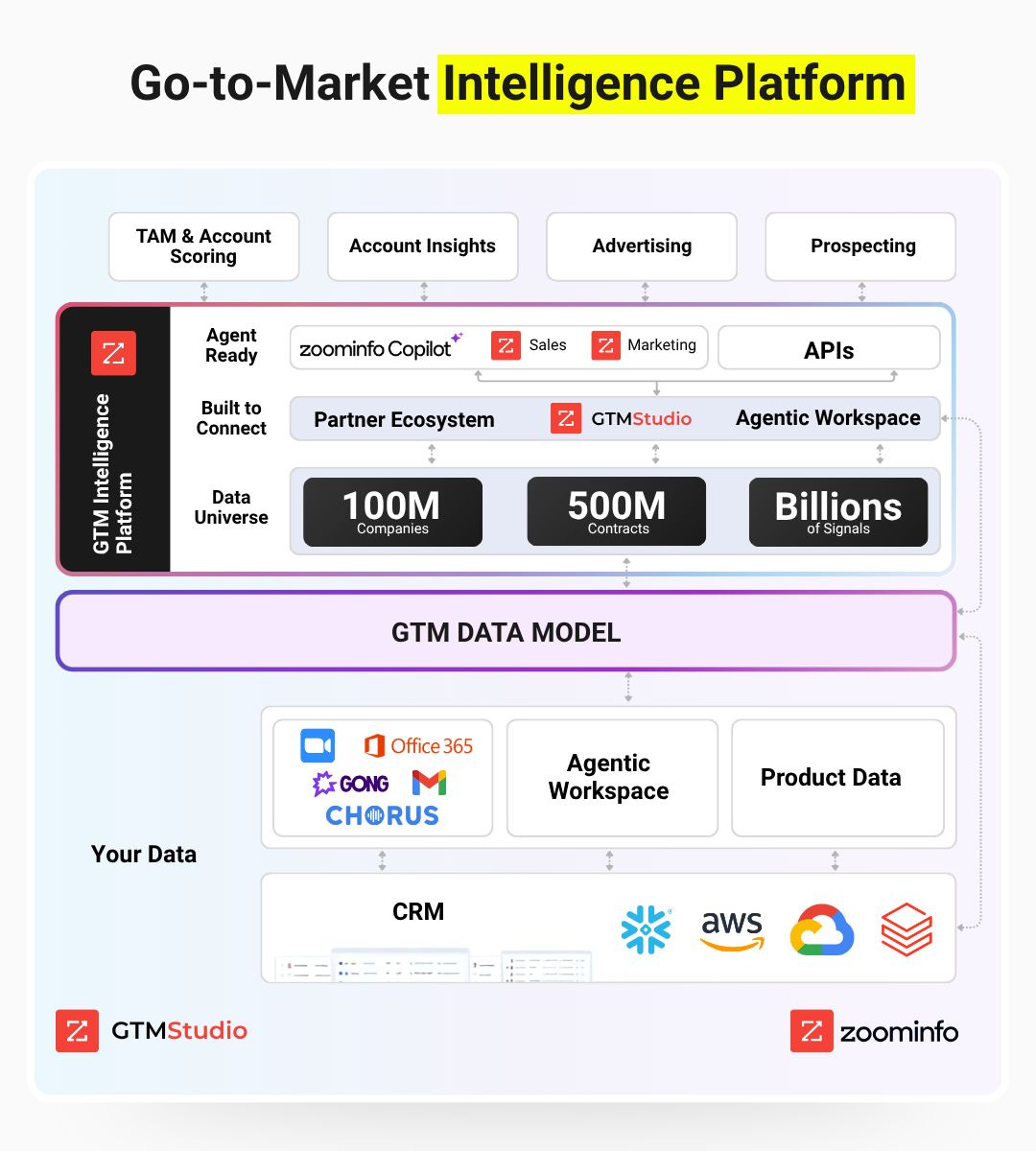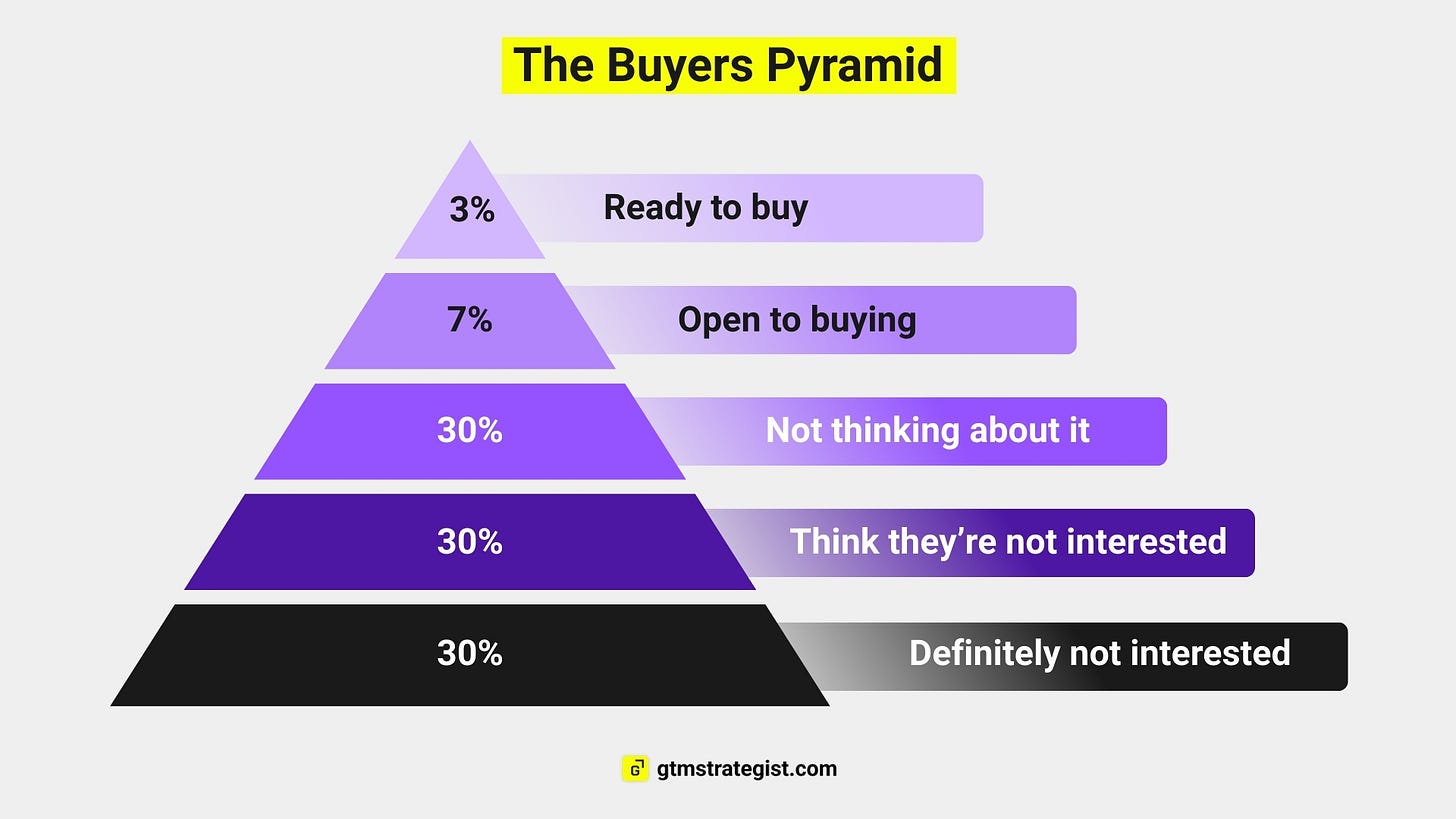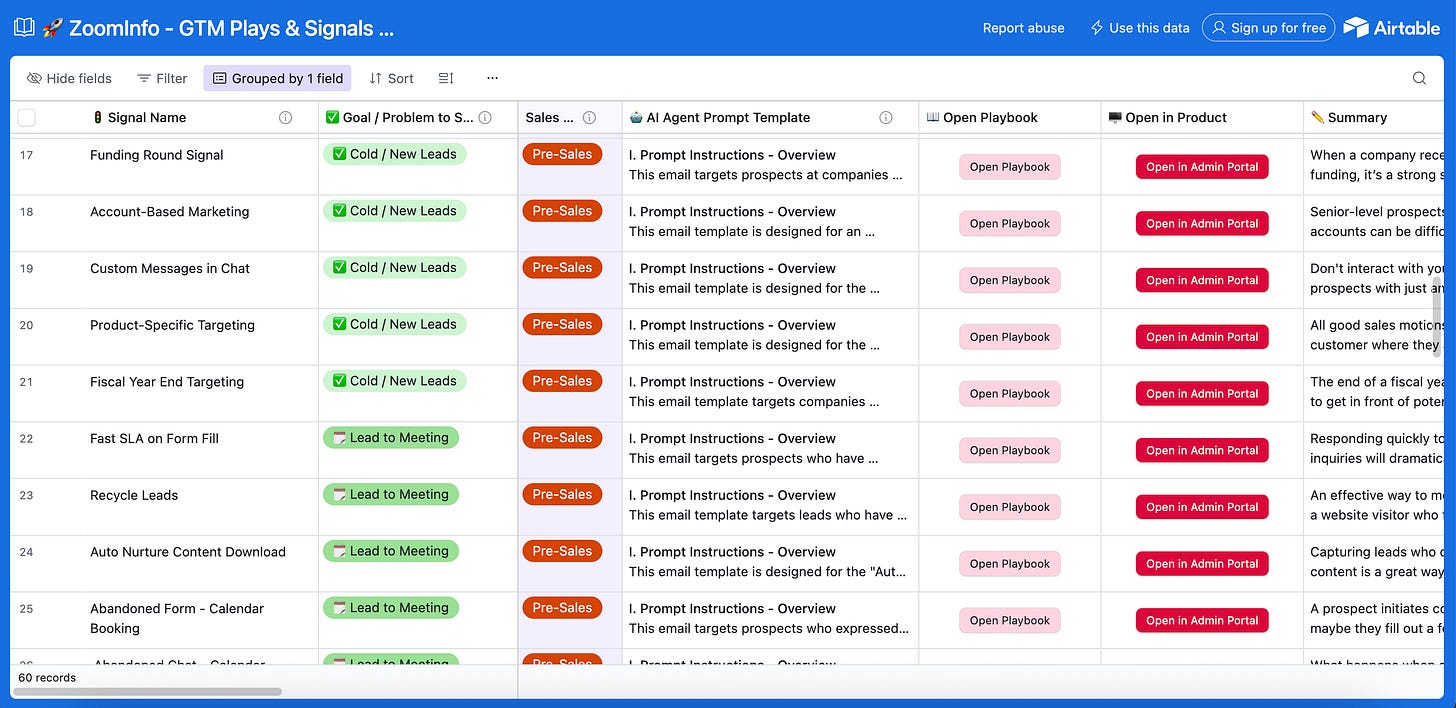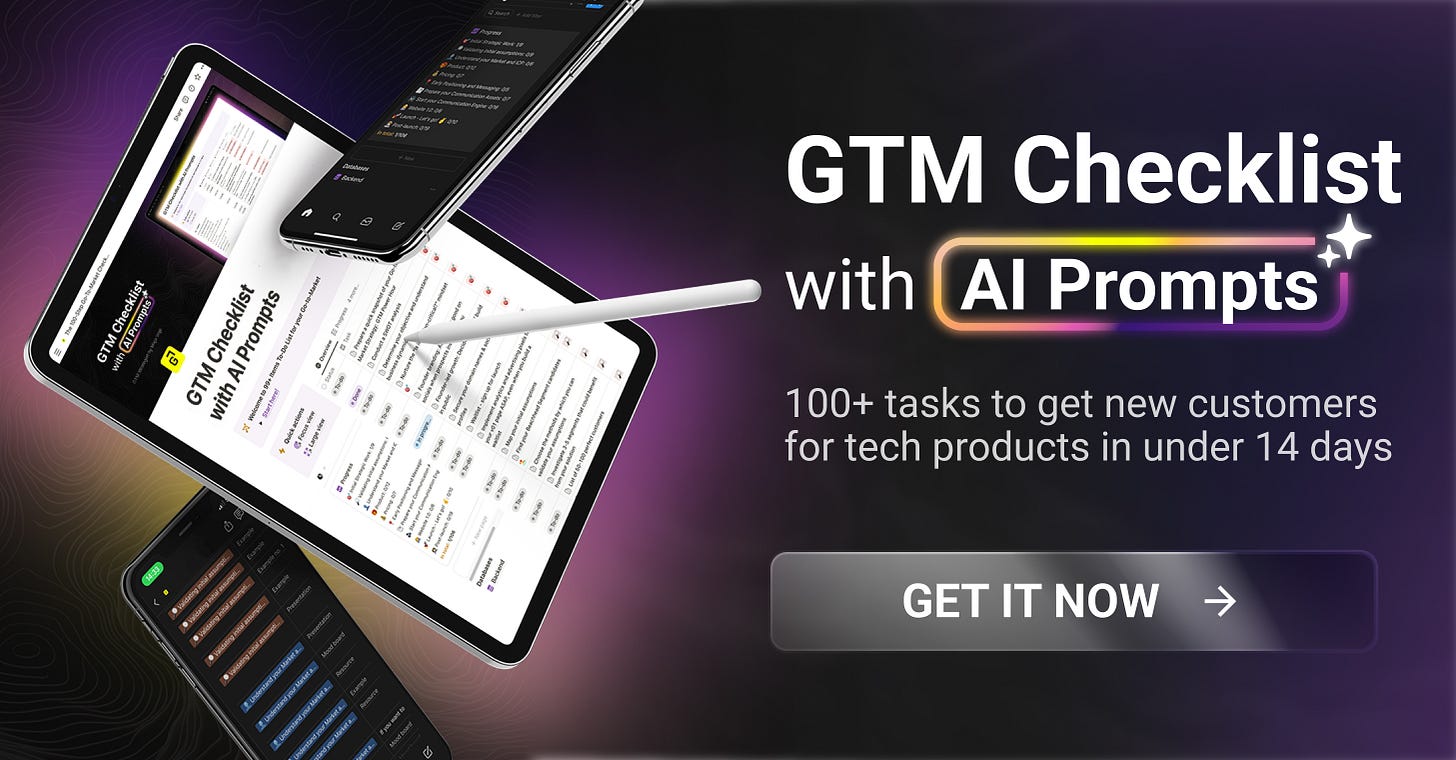GTM in the Age of Signals
Inbound is out. Outbound is in. Plus, a free list of 60 signal playbooks.
Inbound is losing its edge.
Outbound is evolving fast.
And the next era of GTM will be defined by how well you read the intelligence.
In this article, you’ll learn:
Why inbound is becoming harder
How signals transform outbound from “spray and pray” to precision GTM.
The types of pre- and post-sales signals you can act on today (free table inside!)
A step-by-step playbook to start using signals in your own outbound.
The bigger ecosystem vision for building a signal-driven GTM Intelligence.
This newsletter is sponsored by ZoomInfo.
Think you know ZoomInfo? It’s no longer just a contact database.
ZoomInfo has rebuilt itself into a full Go-to-Market Intelligence Platform — one that doesn’t just give you data, but actually executes on it.
Signals come in, outreach goes out, and pipeline moves automatically.
The Shift in GTM
Inbound isn’t dead.
But it’s getting harder by the day.
We’ve entered the era of AI-generated everything. The internet is drowning in mediocre content - blog posts, LinkedIn updates, SEO articles, even eBooks. What used to be a reliable way to pull in leads is now a fight against noise.
On the other hand, the SEO shift is real. You probably already saw what happened to HubSpot’s organic traffic:
You simply cannot expect the same traffic on your website anymore.
The buying journey is moving to LLMs, which are gaining an increasing share of traffic.
How to position for the zero-click reality? It’s still a black box (although this article can help).
That doesn’t mean inbound is irrelevant. It just means the easy wins are gone.
So where’s the edge?
It’s in outbound - but not the outbound you’re picturing.
Outbound - don’t spray and pray. Ecosystem vision
Say “outbound” and most people think of spray-and-pray.
Mass email blasts.
Cold calls to random lists.
0.3% reply rates that burn out reps and budgets.
That outbound deserved its bad reputation.
But here’s what most founders and GTM teams are missing: outbound today doesn’t look like it did 5 years ago.
Outbound has become intelligent.
Powered by signals.
Guided by GTM Intelligence.
We’re no longer guessing who might be a fit. We’re watching the market in real time and moving when buyers show intent.
What are signals (and why they matter now)
Signals are the clues buyers leave in the market that tell you who is ready, when, and why.
Think about it:
A funding announcement.
A surge in job postings.
A new leadership hire.
A product launch.
A spike in intent data searches.
These aren’t random data points. They’re buying signals.
And here’s the key: signals let you flip the script. Instead of waiting for someone to stumble across your inbound content in an increasingly crowded Google search, you can move first.
You see the signal → you act → you reach out at the exact moment when it matters most.
How Signals Turn Outbound into the Fastest Way to Validate GTM
Signals transform outbound from noise to relevance.
Relevance: You’re not sending a generic pitch. You’re reaching out because a company just raised $10M and is hiring 20 SDRs. Your timing isn’t random — it’s aligned with their reality.
Personalization: Your outreach references their context, not your boilerplate. It feels like you’ve done deep research, even when technology does the heavy lifting.
Efficiency: Instead of 1,000 cold emails for 3 replies, you can get meaningful conversations from 50 targeted outreaches.
Scalable precision: With AI + platforms like ZoomInfo surfacing signals in real time, this level of precision is no longer manual — it’s automated, repeatable, and scalable.
Outbound used to be about interrupting.
Nobody likes to be sold to - except when they are already on the market.
Today, it’s about showing up when buyers are already moving.
ZoomInfo recently published an article on this very shift: inbound demand is declining, but outbound is becoming far more effective thanks to signals.
Here’s the core message:
“The most successful teams aren’t waiting for leads to trickle in. They’re using signals to know exactly who to target, when to engage, and how to tailor their message.”
That’s the playbook. Outbound isn’t about blasting. It’s about listening to the market, detecting movement, and acting with precision.
Mini case: Intelligent outbound in action
Let me give you a real scenario.
A founder I worked with noticed a signal: a mid-market SaaS company had just closed a $12M Series A. Within days, he reached out - not with a generic cold email, but with a tailored message about how his product could help their sales team scale faster.
That single signal turned into a warm conversation → a pilot → and within 3 months, a multi-year contract.
This isn’t luck. It’s what happens when you combine signal intelligence with sharp GTM execution.
By the rule of thumb, only 3% of potential customers are ready to buy immediately, and a bit more are actively considering. By focusing on these ones, you optimize your marketing efforts - and budgets.
Here is my recent example.
I narrowed down my very specific offer to only 7 founders of AI SaaS who recently got the investment.
Step 1: Start with the ICP
ICP, or Ideal Customer Profile, is still the way to go. Without clarity here, even the best signals won’t help - you’ll just be chasing noise.
Start with the firmographics:
Industry – Which verticals get the most value from your solution?
Location – Are you targeting globally, or is there a key geography where adoption is faster?
Size – Define both by number of employees and by revenue. A 50-person SaaS startup and a 5,000-person enterprise both buy software, but with completely different cycles.
Then, go deeper:
Technographics – What tools do they already use? Who do they integrate with? Are they on a competitor’s stack you can replace?
Stage – Seed, Series A, or pre-IPO? Each stage comes with different pains and buying power.
Go-to-Market motion – Are they PLG, sales-led, channel-first? The way they acquire customers will influence how they buy from you.
Your ICP is your first filter. It narrows the universe of companies down to the ones where signals actually matter.
When you know your ICP, you can ignore 95% of the noise in the market and focus only on the companies that have the potential to become your best customers.
Step 2: Define your buying committee
Now that you know what type of companies to target - who is the person on the other side? Who do you need to contact?
It might be that several profiles are involved in the decision-making committee or group. One from marketing, one from IT, one from the financials department… The larger the company, the more complex the buying committee can be, and every member will be interested in another aspect of your solution.
Step 3: Mix in the signals
Here is where the signals come in. How to go from a large list to those 3-7% that could be on the market for your solution?
Here are some examples of pre-sales signals from ZoomInfo’s intelligence:
Internal moves: Personnel changes create great prospecting opportunities. For example, when an executive is promoted internally, they typically look to make their mark in the first 90 days, including evaluating existing technology and services and buying new ones.
Competitive tech uninstall: A competitor's customers can be a great source of new business - if you can get plugged into the right signals. Companies that churn from your competitors are already educated on your value proposition and understand its potential. This makes them well-positioned to find a better solution - you.
Website visit: If someone was on your website, it’s possible that they already researched you or that they are at least familiar with your name. In that case, cold outreach won’t really be cold.
Funding round: When a company receives a round of funding, it’s a strong signal that they are likely to begin making new investments to grow their business. It’s an event worthy of congratulations and a natural conversation starter.
Podcast mention: If your prospects were mentioned in a podcast discussing topics relevant to your business, you can leverage this timely and relevant information to initiate engagement, referencing the podcast content and offering a tailored solution that addresses their discussed needs or concerns. Strike while the iron is hot.
However, post-sales signals are just as important for growing revenue and ensuring customer retention.
Upcoming renewals: Don't be caught by surprise when it comes to renewal time. Schedule a customer check-in 90 days prior to the renewal of an existing contract to understand how their priorities may have evolved over the course of the contract.
Low Adoption Engagement: There’s a downsell risk when customers aren’t using the full scope of the product they purchased. Take a look at what each customer is paying for and pinpoint features that are underutilized or not used at all.
Step 4: Orchestrate the campaign
Adapt the messages with personalization and context. Signals are excellent for this stage as well, they provide the rich data for the context.
See it in action - how I found 7 founders of AI companies in the USA who got $3-5M funding in the last 3 months in <4min:
Ecosystem vision: The age of signals
Here is how Millie Beetham, VP of GTM Strategy and ZI Labs at ZoomInfo, describes the role of signals in GTM:
“There is a wealth of data and signals to tap into today. With insights about the businesses you want to sell to—either available out of the box or generated via AI GTM tools like ZoomInfo—there’s a huge opportunity to build an always-on outbound revenue engine. That said, running outdated playbooks that don’t leverage nuanced intelligence about a business and its needs won’t work. You have to get creative with the intelligence you use to nail timing, targeting, and content, or you’ll end up lost in the noise of your target customer’s inbox.”
We’ve entered the age of signals.
Inbound will remain part of every healthy GTM mix. But if even giants like HubSpot are seeing their inbound results erode under the weight of AI-generated content, then founders and GTM leaders need to expand their playbooks.
Outbound is no longer a blunt instrument. It’s becoming the sharpest tool in the box — as long as you use signals to guide it.
The real power comes when you don’t just act on signals once in a while, but when you engineer your entire ecosystem around them.
That means:
Data sources: Funding rounds, hiring patterns, intent data, product launches, tech stack signals.
Tools: Platforms like ZoomInfo, Clay, 6sense, Apollo, LinkedIn Sales Navigator.
Workflows: Automated alerts, AI-assisted prospecting, playbooks that trigger tailored outreach.
People: Teams trained not to pitch blindly, but to translate signals into value-driven conversations.
In this ecosystem, every signal becomes an opportunity — and your team becomes the first to show up when buyers are ready.
ZoomInfo recently published a free table of the best pre-sales and post-sales signals, along with playbooks and email templates. Grab it here.
How to start with signals
If you’re new to outbound, don’t overcomplicate it. Start simple:
Pick 2–3 high-impact signals for your ICP (e.g., funding rounds, job postings, leadership changes).
Build a weekly routine to review these signals in your GTM Intelligence platform.
Create one tailored outbound play for each signal type.
Measure results, refine, then expand your signal set.
Outbound intelligence isn’t built overnight. It compounds. The sooner you start, the sooner you’ll outpace competitors who are still stuck in generic outreach.
The GTM edge no longer belongs to whoever creates the most content.
It belongs to whoever reads the signals best.
📘 New to GTM? Learn fundamentals. Get my best-selling GTM Strategist book that helped 9,500+ companies to go to market with confidence - frameworks and online course included.
✅ Need ready-to-use GTM assets and AI prompts? Get the 100-Step GTM Checklist with proven website templates, sales decks, landing pages, outbound sequences, LinkedIn post frameworks, email sequences, and 20+ workshops you can immediately run with your team.
🏅 Are you in charge of GTM and responsible for leading others? Grab the GTM Masterclass (6 hours of training, end-to-end GTM explained on examples, guided workshops) to get your team up and running in no time.
🤝 Want to work together? ⏩ Check out the options and let me know how we can join forces.









Thank you for sharing this, you’ve explained very clearly! And most importantly…it all makes perfect sense…
Thank you for sharing, I really enjoyed this read (like all of your other newsletters!). Especially the point that outbound only gets interesting once it’s powered by signals rather than volume.
One thing I’d add from our own research at MarketSizer: not all signals carry the same weight. A funding round, job posting, or intent spike may open a window, but without knowing where that account sits on the readiness spectrum, you’re still at risk of mistiming your outreach.
In our analysis of 24m+ subscription records across 110+ Customer Service & Livechat Software Vendors, we found that only a small slice of the market is truly decision-ready, a larger group is in research/consideration, and the rest are either latent or not in-market at all. Outbound without that nuance is just as noisy as the spray-and-pray tactics we all want to move away from.
The real edge isn’t just listening for signals, it’s interpreting them in the context of readiness. That’s when enrichment tools, intent feeds, and outbound precision actually line up to create ROI across Sales, Marketing, and CS.
Curious to see more discussions like this push the conversation beyond “signals or no signals” into “which signals, and at what stage?”